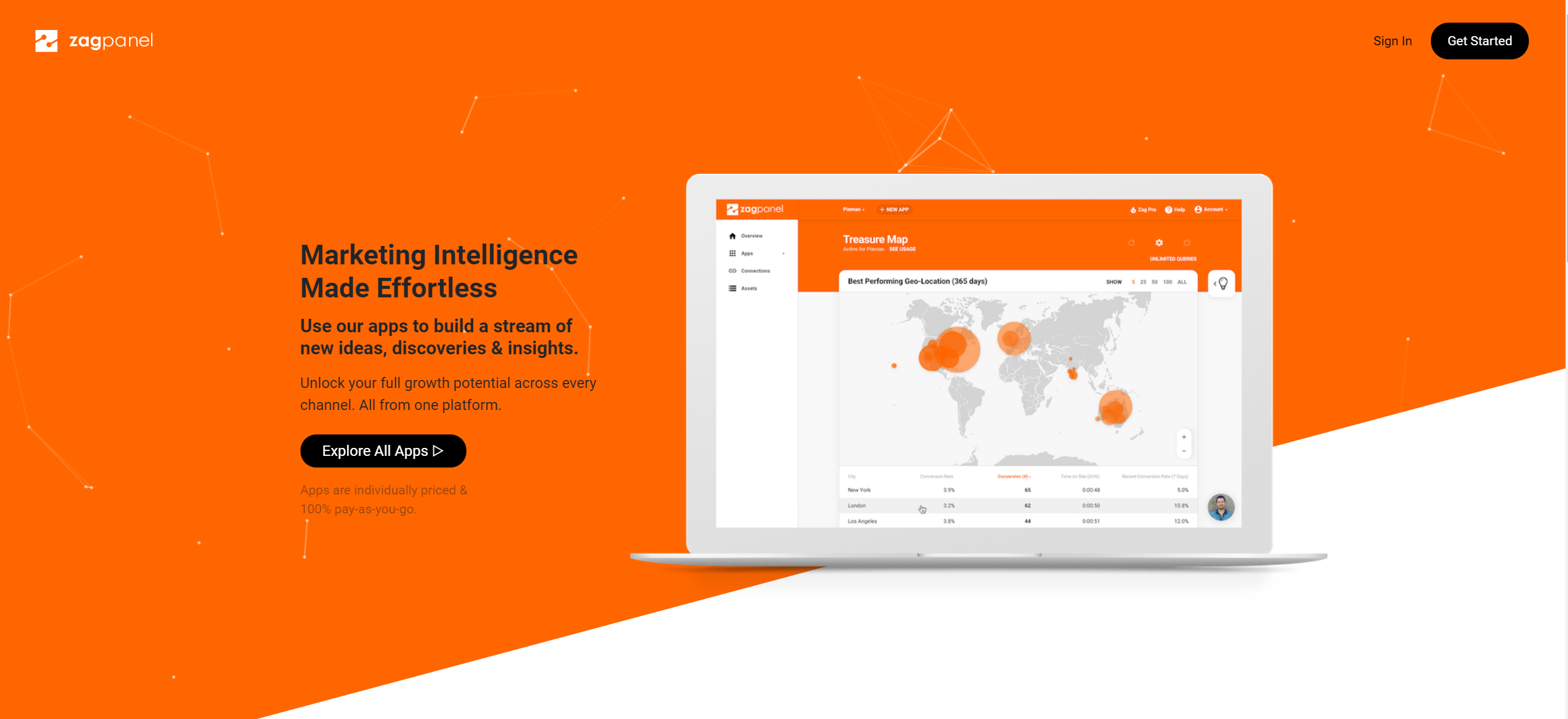In my last post, I talked a bit about the “good product” myth, and why convenience commands premium pricing just as easily – or perhaps even more easily – than quality or complexity.
I also promised to come up with a few hypothetical app ideas for what I call the “convenience bridge” software model (simple little apps largely built with mainstream platforms to offer convenience at a premium).
So in classic late fashion, here it is 🙂
This post will cover what I view to be probably the smartest business model for software & app developers, right now.
Here’s why:
- Simplicity. These are the easiest types of apps to build
- High Margin. Generally the pricing for the “convenience bridge” vastly exceeds what the underlying platforms (that drive your app) charge its own retail end-users.
- Minimal Barrier. Plenty of dev talent abounds – the API’s you’ll be building on are well-known quantities, and most of the core infrastructure can be built with open source assets.
- Lean & Fast. Going from concept to MVP (minimum viable product) can be as little as 30 days
- Tap Existing Audiences. In many cases, your “helper app” can draw a substantial portion of its customer base directly from the underlying services, for free. Especially if they have an app marketplace.
That last point is especially valuable. But more on that further down.
Let’s kick things off by quickly examining the business model at the macro level – and look at why apps like FaxBurner, Mover & Boomerang are arguably pure genius masquerading as simple little tools.
The Secret to Milking It…
It sounds strange, but the best way to introduce this model is by comparing a fancy glass of wine at a nice restaurant with a completely un-special carton of milk from a convenience store at 1:00 am.
Milk vs Wine – Similarities:
– In both cases, you’re paying a substantial premium over the MSRP (usually about 2-3X more than the grocery store)
– And in both cases, there is basically zero turmoil in resolving to overpay for a staple commodity. Sometimes by as much as 100 – 200% above normal retail prices.
Milk vs Wine – Differences:
– When you’re at the fancy restaurant, you inherently expect a great overall experience & attentive service to justify the price premium. You’re paying for the atmosphere, and you go to great pains to ensure that your night out is the best it possibly can be.
– In contrast, there is zero energy expended about how to ensure the best experience, or the most desirable atmosphere, for milk procurement at 1AM. You don’t pull over to look at the reviews on Yelp, or poll your friends on Facebook about which shitty convenience store with buzzing lights they would most recommend.
The Takeaway:
This is the subliminal power of “convenience as a product”. Whereas the fancy restaurant has huge fixed costs, substantial waste, endless staff turnover, and demanding customers – the shitty convenience stores simply need to exist. And if they exist in the right location, and sell the correct types of un-special items, they can effortlessly generate huge gross margins on each transaction from their indifferent customers who expect nothing special from them in exchange for paying absurd prices for everyday commodities.
And that, friends, is the secret to selling milk for the same ridiculous margins as a glass of fine wine (with a fraction of the operational expense).
Now, if you’re reading this – I’m guessing your aspirations go beyond opening a local Kwik-E-Mart. So, let’s explore some hypothetical app models that sell convenience as a product.
Who knows? Maybe one of these ideas (or a derivative thereof) could be your next million-dollar journey…
Here’s Some Killer ‘Convenience App’ Ideas
That I’ll Never Get Around to Building
Well, at least me and my Mom think they’re neat ideas.
Your mileage may vary…

Before we get started – a few disclaimers and pre-apologies:
– These ideas almost certainly already exist – either in exact or similar fashion. I’m not promising that these are unique – and the thing is, they don’t have to be unique. They just need to be the right fit for the right person at the right time.
– I have not fully vetted the commercial viability of any of these ideas
– Where I mention API’s that could potentially drive the app – that doesn’t imply any due diligence as to whether the underlying business is friendly towards commercial API usage. (When in doubt, ask).
– The “app names” I’ve lazily come up with are also probably not unique, and any resemblance to actual apps/services/whatever, living or dead, is purely coincidental.
[/alert]Sound good?
Alright, let’s dive in…
—
Killer App Idea #1: “The Bargainator”
What it does: Finds you bargains on specific items by continually searching retailers, auction sites, & local classifieds for the best price, every day. Notifies you when it finds items below a set price target.
Business model: Freemium & Affiliate
How it works: You start by creating a new “Bargain Hunt” (project), and enter product keywords and ideally a SKU code. Using both bots and humans, the Bargainator perpetually scans every online retailer, auction site & local classifieds sites (according to your location / criteria), and notifies you when it finds the product listed for a price within your target range.
The cron runs daily for each project, pulling data from Amazon’s & eBay’s affiliate API (and various other retailers that offer affiliate feeds via API). You can optionally have human virtual assistants conduct actual searches on your behalf to try and find used items on the various local classifieds sites in your area, which is a premium service, starting at $X per product per day
Each day, both the humans and bots post their findings (URL & price) into the app’s daily results queue. You are notified if the price falls under a prescribed threshold.
How’s it made?: The core infrastructure of the app is pretty simple – it takes the core idea behind Chintzee (which simply pulls Amazon affiliate feeds and runs some basic data visualization), and adds a few more feeds from other retailers & Ebay, perpetual automation, price targeting, and an upsell for human intervention on classifieds sites like craigslist, kijiji, and so on.
The human intervention product can be fulfilled via API with services like MicroWorkers, Scale or FancyHands. You would ideally price the VA services at somewhere around a 500%+ markup if possible.
The app would be free to join and would predominantly be used by “free users” that would monetize on their occasional purchases (affiliate). The power users and flippers would happily pay the premium to enlist a team of prospectors to find key items on organic marketplaces like CL where pulling from “feeds” isn’t really viable. There could even be additional service functionality built-in where they could contact the local sellers on your behalf and add meetings to your Google Calendar… etc.
Main audiences & marketing channels: High-ticket shoppers, luxury item buyers / procurement agents, Ebay flippers & upcyclers. Grow the initial userbase by advertising on FB, key subreddits, & PPV. Increase retention by extending out the platform to IOS, Android and a Chrome extension. Once you have a clear handle on your LTV, then consider scaling growth through affiliates and pay per lead / install.
End game: With enough users, there’s arguments for a significant consumer channel, as well as a valuable data play. You’d want to store the majority of your user behaviour in your back office so that it could be quantified for various go-to-market positioning strategies (in your teaser deck & data room).
Key prospective acquirers would be major retailers, auction sites (Ebay et al), and data vendors (like Oracle, Lotame, etc.). Or if you’re okay with a 10 year earnout, private equity might be an option as well 😉
—
Killer App Idea #2: “Fallout Scout”
What it does: The Fallout Scout is a stock screener with a twist – it runs a multi-staged process to identify stocks that could be temporarily trading at a discount for no other reason than being “guilty of association” to a bad apple in the same industry, or bad news in the industry as a whole.
Useful for value investors & momentum traders for generating initial ideas.
Business model: Subscription + PAYG
How it works: You start by creating a Project, and then entering basic screening criteria like industry/sector, market cap range, minimum share price movement % to trigger shortlist, and various similar screening factors. The app then runs a screening cycle based on the user’s settings, at $X per cycle.
What the app screens for is two things:
1) Stocks that meet your criteria, and whose share price has fallen in the most recent cycle by your % trigger (which should lean towards extremity)
2) News related to the companies in question. Using sentiment analysis & aggregate stock analyst buy/sell ratings, the app determines if the company seems to be getting widely trashed in the media.
If the stock(s) meet both of those criteria, you (the user) are notified, and asked if you want to analyze the related competitors. This can either be a manual action or set to happen automatically.
As a last step, the app then looks for negative price movement in the competing companies and shortlists them, but highlights those whose values have decreased, but where the aggregate news sentiment is less negative, neutral, or positive. These are the stocks that might be getting dragged down with the “bad apple” simply by association, and could be temporarily trading at a discount.
While this is far from an automated stock picking service, what it does do is automate perpetual idea generation for a momentum strategy.
The app likely makes sense as a base subscription that covers X number of daily cycles. Extra cycles are billed as an overage, PAYG. Your profit margins on actual cost would be substantial (1,000% markups, ideally)
How’s it made?: The app’s infrastructure is surprisingly simple. It’s just a stock screener, a news scraper, and a sentiment scoring engine.
There’s numerous free API’s where you can get financial data, including Alpha Vantage and Google Finance. You can optionally use an AI decision weight engine like Fuzzy.ai to aid with initial “discount screening” in comparison to median value.
Similarly, news feed API’s abound: Webhose, NewsAPI, plus various universal scrapers like Import.io, Apifier and so on.
Lastly, for developing out the sentiment scoring capability – this is surprisingly simple by plugging in a service like Indico, which uses machine learning to score text & images, returning sentiment values on a percentage scale.
Main Audiences & Marketing Channels: Mostly retail investors who dabble in day-trading, value investing, swing trading, and so on. There might possibly be some interest from hedge funds or similar institutional-level traders (but most of those guys invest millions into building their own quant engines).
Facebook, relevant subreddits, GDN, RTB & PPV would be the channels I would start with, with a goal to ironing out numbers and then finding long-term direct placements & channel partners (affiliates, basically).
End game: As a relatively straightforward investing SaaS app, there’d be plenty of interest from various acquirers in rollup mode, the most obvious suitors being online brokers who could just bolt it into their platform and add a new leadflow channel.
There might be a data component to a degree, or an IP argument, but these would probably be viewed as “icing”, where your userbase & growth channels are the “cake”. The valuation would probably just be an earnings multiple.
—
Killer App Idea #3: “Smart Snoop”
What it does: Smart Snoop provides “person intelligence”, on-demand. It can build out a full professional, social and background profile on someone just by using their email address. The primary mechanism is via a Chrome extension, which simply embeds a branded “lookup” icon beside any email address visible on a page. Users can also run a manual search from the web-based interface, if needed.
Useful for salespeople scoring leads based on a person’s role & network. Useful for startups and marketers by identifying influencers based on social data. And useful for pretty much anyone who needs to verify someone’s background/history (employers, landlords, dating site users, etc.)
Business model: Freemium + PAYG
How it works: You start by creating an account & installing the Chrome extension (which can be toggled on/off as needed, with the ability to save those settings on a domain basis). After it’s installed, the extension will automatically inject a small icon next to any email address it detects on a page. These icons might also be more directly integrated into services like Gmail and LinkedIn.
When you click the injected icon, a lightbox pop is generated that walks you through a staged lookup process:
1) Would you like to Snoop somebody@company.com? Yes / No
2) If YES: You’re presented with two options…
– Click here to Get an Enriched Business Profile for somebody@company.com for 5 Credits [No Hit No Fee – View Sample]
– Click here to Get a Full Background Report & Profile for somebody@company.com for 15 Credits [No Hit No Fee – View Sample]
3) The search either succeeds or fails. If it succeeds, the results are saved to the “cloud” and can be accessed at any time by the user either on-screen (in Chrome), or in the Smart Snoop app.
Users would probably start with 3 free searches or something, after which they could load the app with credits (and simultaneously setting up a billing profile for one-click ordering thereafter). The overall idea here is to make professional research, customer insights & background screening one-click simple and always available as an option. For sales teams & marketers, this puts world-class customer intelligence at their fingertips without any integration or setup, whatsoever. And for employers, landlords, and whoever else would find a one-click background checks useful (right from their favorite email service or social media platform), it’s a no-brainer.
How’s it made?: The service is both a Chrome extension, and a simple web application where users can run manual searches and view previously saved search results / background reports. The majority of transactions would initiate from the Chrome extension, via the injected buttons into pages and key services like Gmail. (Check out Exstensionizr – a simple storyboarding app for getting the dev process started for Chrome extensions)
The enriched business profile data would be pulled from the FullContact API, and the full background reports would be pulled from the Checkr API. It’s really quite a simple mashup.
Main Audiences & Marketing Channels: Primarily aimed at B2B users, as the app universally applies to hiring, screening vendors/partners, sales & marketing. Could additionally target the dating demographic, who might find the Background Report feature useful (and it could be baked into most dating site UI’s pretty easily via Chrome). Facebook, GDN, RTB & PPV (filtered to Chrome + Desktop) would be the natural starting points for traffic channels.
End game: While the app itself is (very) simple, I think given the sheer size of the TAM/SAM/SOM and the direct overlap between your customer base and that of companies like SalesForce (with a $63 Billion market cap), if you developed any kind of notable marketshare you’d probably be scooped up at a premium just for the user base alone. So, while the online-dating angle might technically offer a larger audience, that might not be the place to focus if a premium acquisition is your ultimate goal.
—
Killer App Idea #4: “One-Second Expense Reports”
What it does: Not the most inventive name (whatever, it’s 2AM at the moment), but the One-Second Expense Reports app is pretty damn awesome, because now all you have to do is literally take a photo of a receipt or an invoice, and then push it to the One-Second app with your IOS or Android device. Once you’ve done that, the app automatically saves the scan to the One-Second cloud, sends a copy to your various cloud accounts (Drive, Dropbox, etc.) for redundancy, and then puts it in the queue for humans to:
1) Transcribe the receipt to text, and
2) Enter the basic transaction details, dollar amount & sales tax details into a Google Spreadsheet that you own (along with a hyperlink to the scan image itself)
Basically, it’s a digital shoebox that will make your life 100X easier as a business owner, or someone who needs to track expenses. And from G Sheets, it’s very simple to export that data into mainstream accounting programs like Quickbooks, etc.
Business model: PAYG
How it works: One-Second is a mobile app that runs on IOS & Android. It’s very similar to any number of those existing “scanner” apps, but the human transcription & data entry is obviously the big USP.
Users simply open the app, which interfaces with the onboard camera of whichever device to take the initial snapshot. Like most scanner apps, it would require 3 photos to ensure that one will be high enough quality for transcription. After the photos are snapped & stored, the user verifies the transcription, after which the scans are placed in queue, and the user is informed of a 48-hour turnaround until the data shows up in their G Sheets.
If the user has multiple businesses or top-level expense categories, they can specify what the expense is “for” when they’re sending it to be transcribed. Each biz/category would have its own internal folder and separate G Sheet.
Ideally, the pricing model would be very simple. Simple receipts would be in the high $0.XX’s per transcription, and larger invoices (full-page) would be in the low $X.XX’s per transcribed page. The user would set up a billing agreement on intake, to facilitate one-click orders thereafter (on verifying a transcription). Populating the G Sheets & automatic file management / redundancies would be priced into the transcription fees.
How it’s made: Technically speaking the app is very simple. The internal cloud photo storage is handled by Amazon AWS (and the user’s optional additional cloud services). The app also connects to the user’s Google Drive (for permissions to create spreadsheets)
Like with “The Bargainator”, the human intervention piece of the equation can be fulfilled via API with services like MicroWorkers, Scale or FancyHands. You would ideally price the VA services at somewhere around a 500%+ markup if possible.
Main Audiences & Marketing Channels: Primarily aimed at small-business users, and to a lesser extent professionals who need to record expenses for their employers. This is a mainstream, wide-appeal product where virtually every channel reaching SMB’s & the self-employed demographic is going to fit the demo. Facebook is probably the easiest to scale quickly.
End game: Depending on the execution and the “slickness” of the app’s UI, I could really see this idea exploding (and would be amazed if it hasn’t in some way already). It would seem reasonable that with a notable user base, any accounting software companies actively rolling up market share in the same space would be potential acquirers – including TurboTax, Intuit, QB, Wave, and so on.
—
Anyway. I can do this all week – but there comes a point where I have to actually press the “publish” button. So in the interest of me finishing this damn post… let’s move on from the hypotheticals, and wrap things up with some tangible starting points for actually generating ideas and getting shit done in general.
—
Building Blocks & Starting Points:
There’s plenty of giants. Might as well stand on their shoulders…
While I really can’t feasibly explain the minutia how to start, run and grow a software business in the next few paragraphs – what I can do is make a list of my “starting points”.
These are the resources I frequently tap into for coming up with ideas, for finding help, for managing stuff – and so on:
Generating Killer App / Software Ideas:
* Inc 5000 List
* Term Sheet
* ProductHunt
* Zapier
While the Inc 5000 and Term Sheet are more esoteric and seem somewhat unrelated to app ideas, they’re a great gauge of what businesses are growing fast right now. This gives you the pulse of the market across every major sector – and in time – the resultant “app ideas” start to present themselves from enough exposure to a never-ending slough of proven concepts.
ProductHunt typically attracts the “it crowd” & millenials, which gives you a window into what the early-adopters are excited about.
Zapier provides automation as a product between hundreds of SaaS platforms & digital services. Almost every single one of their featured “Zaps” could easily be expanded into a standalone app and marketed with some level of success – especially where the underlying platforms have a large audience or a built-in marketplace. A goldmine of ideas for the convenience-bridge model…
Building Blocks:
* Programmable Web
* Bootstrap
* Kendo UI
* Grommet
* Chart.js
* SendGrid
* AWS Cloud Storage
Bootstrap, Grommet & Chart.js are industry standard, open source frameworks for constructing any app (web or mobile).
Kendo is a bit more specialized for B2B applications and isn’t open source, but I find their library to be a few notches above the open-source options in most cases. And I like their visualization templates a bit more.
SendGrid is essential for transactional emails. AWS is obviously something you’ll need for CDN & file storage if your app requires it.
But the big one here is ProgrammableWeb (PW). This is basically the search engine for API’s… and will come in very handy when you’re figuring out how to actually turn your napkin sketch into a viable idea.
Getting Help:
* TopTal
* WeWorkRemotely
* 99Designs
* Dribbble
* StackOverflow
* And yes – even Upwork
TopTal might not be in everyone’s budget, but if you need something built right – I’ve found them to be a substantially better talent pool than the usual freelance networks. WeWorkRemotely is like a casual version of TopTal, and many of my friends with tech companies, etc. use them frequently.
99 Designs is great for on-demand design stuff that’s a bit one-off, and Dribbble is a great way to prospect for longer-term design talent.
StackOverflow is basically a problem-solving sounding board for fixing dev problems, of which you will have many (hundreds), especially if you’re venturing into software/app development as a newbie.
And lastly, yes, it’s still possible to find normal humans with actual talent on Upwork. Just be prepared to be bombarded by offshore “agencies” (coding mills, essentially).
Organization, Productivity & Getting Shit Done:
* Axure
* Slack
* Trello
* GitHub
* Webflow
Axure is my absolute favourite prototyping & wireframing program. I’ve used it for years. I find it’s still the fastest way for me to get my ideas across to developers, designers & product management – where everyone can understand the “universal” language.
Slack & Trello are essential for developing anything as a team. Slack is basically a better version of focused email, and Trello is a way to easily stage out the development process into modular goals, and then knock through them all in sequence. Both Trello & Slack play well together as well. (If you’ve been using old shitty project management apps like Redmine, you will thank me).
GitHub is a cloud-based repository that simultaneously provides a subversion (persistent backups) of your code, while enabling multiple developers to build on the same repository. Anyone who doesn’t use a repository for any dev project is a moron. And I’ve found that Git is the best of the repos.
Lastly, WebFlow is a true WYSIWYG HTML editor that doesn’t dumb anything down – essentially it’s the spiritual successor to Dreamweaver, but better. I use it to spec out front-end sections and marketing site copy, which a designers can then more easily build from (vs a wireframe).
General Tips:
– Your most important hire will be a full-stack developer. Don’t settle for someone who’s lackluster, slow or just a “problem-finder”. Focus on finding someone who naturally seems creative, and can actively find intuitive solutions to problems & hurdles (of which you will have several).
Many developers fall into the “tell me what to do and I’ll do it” skillset. It’s rare to find someone who can look at a big-picture roadmap and design solutions to suit high-level objectives, rather than simply building to spec.
– Getting traffic is the easy part. Converting traffic into users, and users into customers, and customers into high-value customers… THAT will be your primary challenge, and needs to be your focus. The traffic part of the equation is relatively easy, and should eventually be outsourced anyway.
– Further to the above (ARPU), it really comes down to your model. Great copy, fancy conversion tricks/widgets will only go so far. Your business model is what determines how you can frame your offer, how much you can charge, how often you generate transactions, and ultimately how much each average customer is worth. This is truly what can make or break your entire business.
– Cold traffic first. Do not rely on organic, “going viral”, getting press, mailers, etc. Prove your concept with cold traffic and people who don’t give a shit about you as the “founder”, or have any idea who you are. Let your product stand on its own, and adjust the funnel/messaging/whatever as needed until it generates an ROI. Then focus on organic, viral, press, mailings, & other channels. Once you know that you’ve got a ringer.
– Integrations, bespoke marketplaces & channel partners are a goldmine. After you’re cold-traffic proven, look for opportunities to integrate or plug into widely-used platforms that much of your SOM is already using. I’ve yet to encounter a more efficient, consistent strategy for drip-feeding growth at minimal cost.
In particular, consider focusing on channels with high commercial intent. For example, while WordPress is used by millions of websites – it’s also free, and inherently the plugin universe is generally expected to be free, or at least freemium. In contrast, its paid competitors like Wix & SquareSpace obviously have a smaller user base, but those users have also self-identified as in-market buyers.
So not only would your integrated plugins/apps have less competition on a smaller platform – most of its users are more apt to pay for it as well.
– Sometimes the best way to compete is to simply “re-categorize” a tried & true model. For example, is there some “killer app” in the Digital Marketing space that you’d love to build… but where it’s already too saturated with competitors? Why not re-categorize the idea and apply it to a sector like Real Estate, Insurance or Dealerships?
– And lastly: As much as you should have an exit plan… don’t assume that selling is inevitable. I see lots of tech companies whose business model is really more of a funding model. They basically just focus on continually raising capital, and then at the end of their careers as founders, they look for someone to take everyone out (themselves & their investors). This often happens without any significant revenue, and almost invariably low (or zero) EBITDA.
If you love the idea of creating buzzword business plans, trying to hit insane growth targets that increase every 90 days (usually with hand-to-mouth, can-kicking strategies), and being forced to earn your investors 1,000% on their money at the expense of your own personal freedom for several years (and where selling at a premium to some ruthless PE firm is the only way out), then great – you’ll love raising capital.
I’m half kidding, but the point is – there’s a lot of upside if you can bootstrap. Even if that means building a “smaller” company, or growing a bit slower.
But if you’re hellbent on the exit strategy being the primary windfall event, then be aware that if you can’t find investors – or if you can’t ultimately find an acquirer… then you could literally have earned $0 (or very likely, a very large negative number) when it’s all said and done, if you only optimize for the endgame.
That’s why I’m a big advocate for building ideas around a profitable model that can actually produce dividends, from the beginning. You’ll find it’s a lot easier to find buyers for a profitable business, too.
—
A Bridge Not Too Far…
Well folks – given the space constraints of a blog, that’s about as best as I can describe “the formula” for the killer app.
In accordance with the various doomsday prophets of internet marketing back when I was a “student” (back in the early 2000’s) – the internet really has congealed into a small grouping of big players who’ve reached critical mass.
You & I have no chance at toppling Google, Facebook, Twitter – or really any major platform.
But ironically – as a direct result of this “congealing” – the big bloated platforms are all fighting a war of attrition, rather than growth. Which is why today’s overall framework for how these big platforms tend to function is very developer-friendly.
In fact, the only way the giants can retain market share & stay relevant is by outsourcing their innovation to channel partners (that’s you & me), who can in turn build ideas, apps & entire businesses on top of their gigantic platforms.
In short – the giants actually need us to interface with them. (Otherwise they’ll shrink).
Never has mutual usury been this much fun 🙂
—
Hope you enjoyed.
Questions? Comments? Creative insults?
Comment below 😉
~ Chris
P.S. My next post will introduce a “convenience platform” that myself and the team have been working on for nearly 3 years at this point. (I have a feeling you’ll like it.)







Oh Great. Now you’ve infected my mind with something else. Ever since your last post on convenience I’ve had this alert signal going off again and again. Oh look, he’s right, convenience won there, and convenience could be a killer here. How appropriate that you should follow it up with killer app suggestions. Thanks for your infectious thoughts. They sure beat looping an old song in my brain throughout the day.
Chris,
Thanks for your insightful analysis and suggestions.
Looking forward to reading about your “CONVENIENCE PLATFORM.”
So brilliant, as always – love reading your stuff!
This is some really smart stuff, and if I wasn’t all-in trying to grow my business right now, I’d take the stock idea and run with it.
Somehow I missed your March post, and I’m always watching closely for anything from you (hmmm… maybe a “Rempelificator” chrome extension that announces anything you do? 🙂 That was a fantastic post, and I hope people re-read it a couple times and realize the multiple layers of insight.
We’ve been pretty successful in our niche-focused marketing business, mostly because we’ve been doing it for a lifetime and have decent word-of-mouth. But outside of referrals, it is absolutely agonizing to get new clients any other way.
Just in the last month I had an epiphany, which your post 100% validates – and fills in some blanks for me. I’m probably stupid not to have seen it earlier, but too heads down/too close to it/whatever.
Our team does amazing marketing campaigns for people, exquisitely designed and customized using their assets or creating new ones when necessary, deeply researched after getting access to AdWords and GA and their FB ad account, etc.
And do you know how f’ing long all of that takes? And how many different people need to be involved on the client’s side?
God forbid we try to do a “prove it to me first” campaign for a big client when there’s not much of their skin in the game.
Again, completely aligned with the “convenience” post, you know what is starting to resonate extremely well with new prospects? A new, generic (but still well-designed) campaign up and running and generating phone calls within 72 hours – WITHOUT requiring hardly any of their time or involvement. Only then do we start iterating, getting their buy-in to get more from them and make it better and better over time.
I feel really stupid not to have seen it earlier!
Sorry to go on for so long, but I thought I’d provide some additional real-world feedback from a little guy about how big a deal convenience is.
Thanks again, Chris.
Scott
P.S. Still haven’t done the 997 yet, someday…
Great to hear from you Scott!
Totally hear you on the effort / reward ratio (building PMP’s for clients)… it takes forever.
I think you’ll be especially interested in what I’ve been working on, given that particular challenge 😉
Also – the clean 997’s are getting harder to find these days! I perpetually watch for GT3’s up here in Canada, which almost never come up anymore.
Then again, the C2S coupes are pretty sweet too…
Talk soon!
It always like unwrapping a present the odd occasion a Chris Rempel email arrives in my inbox! This one in particular is up my alley too. I have a full-stack mobile app/PWA(progressive web application) starter project that I sell, basically a clone of Tinder, which has a lot of core common functionality required for an app. Its a bit of hobby income but I would like to leverage what I’ve built to be able to quickly build out some other ideas with more potential. Some food for thought!
Sounds like a solid framework Daniel. I could see something like that growing into a sort of “themeforest” for apps.
Nice!
I love the synchronicity! I am working on an app idea right now and this will help a lot. Thanks so much for writing this Chris.
One tool you did not mention is gitlab. They are very much like github but even better in some ways.
Like being able to have lots of free private projects. github has restrictions on this or you need to get a paid account.
Another is rackspace which has some very cool cloud services. One is very inexpensive file storage that is simple to use AND can be used to host static sites. This is perfect for static blogs or pages hosted on a subdomain like blog.domain.com
Thanks again Chris!
P.S.
Are you bored and running out of things to do? I already know the answer! I am reading a really great book by Chris Voss all about negotiating. He was the top FBI hostage negotiator for years. Now he applies his experience to life and marketing. The book is called: “Never Split the Difference: Negotiating As If Your Life Depended On It”
I am coming over to Victoria to visit family in June.
If you would like to meetup and have a chat over coffee send me an email.
Carpe Diem
Thanks for the tip on GitLab, Rick – I’ve seen it come up every now and then, but always thought it was just some plugin for Github, lol!
Didn’t realize it a completely different platform. Cool.
Shoot me an email when you get into town, always up for coffee 🙂
Talk soon,
-Chris